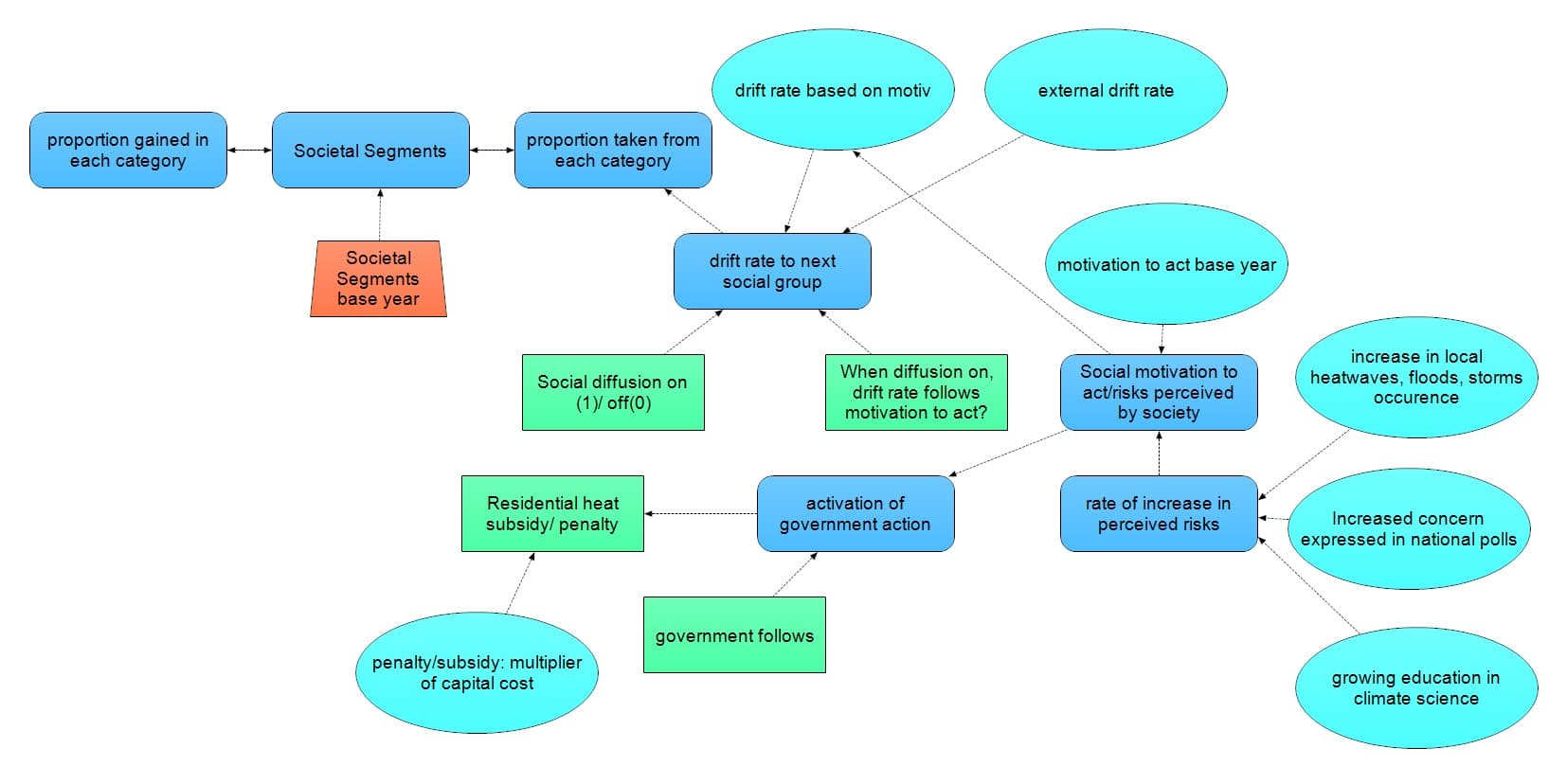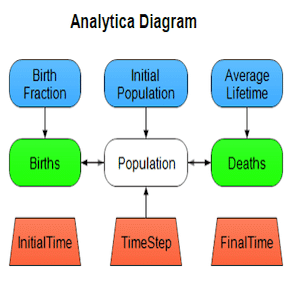The Paris Climate Agreement’s target to limit warming to 1.5°C requires not just technological innovation, but a profound socio-economic and cultural transformation. The United Kingdom has legislated a net zero greenhouse gas (GHG) emissions by 2050. To achieve this it is essential to understand changing societal attitudes to the energy transition. Understanding and integrating the complex interplay of technological, societal and environmental factors is crucial for effective energy policies.
The challenge
Energy system models traditionally focus on techno-economic factors, and overlook the crucial role of societal behaviors and attitudes. This gap limits the understanding of the real-world dynamics of energy transition, including the adoption of new technologies and societal responses to policy interventions. The challenge lies is to incorporate non-monetary barriers and drivers, such as resistance to change and the diffusion of environmental values. This integration is essential for exploring potential future energy pathways and informing policy decisions towards net-zero emissions targets.

Why Analytica?
The University College, London (UCL) team chose Analytica as their platform to develope an innovative model to address this challenge.
“Analytica has been a key software platform for energy modelling at UCL. It let’s us represent complex relationships and feedbacks in long-term UK energy transition scenarios. It has been invaluable in explaining the dynamics and uncertainties in any transition pathway to senior policy makers.”
Professor Neil Strachan, Director and Head of Department, UCL Bartlett School of Environment Energy Resources (BSEER)
"I've found Analytica to be a comprehensive and versatile platform for detailed representation of the techno-economic components and dynamic societal structures of the national energy system. As a system dynamics modeler, I appreciate that I can incorporate dynamic variables (stocks and flows) and use systems thinking alongside traditional modeling features."
Brunilde Varrier, Research Fellow in Social-Technical Energy Transitions, UCL Energy Institute
The solution
An interdisciplinary research team from UCL developed a model of the UK energy system, focused on residential heating, that integrates social dynamics into energy system modeling. Their approach uses survey data to understand public preferences and resistance to adopting new heating technologies. They incorporated this data into a probabilistic energy system model called BLUE (Behaviour, Lifestyles, and Uncertainty Energy Model), which includes social mechanisms of change. The model explores potential pathways for energy transitions rather than predict optimal paths, and emphasizes the influence of non-monetary factors on decarbonization targets.
The BLUE model, developed using Analytica, provides a groundbreaking solution to the challenge of integrating social dynamics into energy system modeling. It features imperfect decision-making in investments and captures uncertainty through a probabilistic approach. The model encompasses three perspectives: techno-economic, socio-technical, and socio-political, highlighting the multidimensional nature of energy systems.

The model’s decision variables included global climate ambition, UK demand drivers, and various behavioral parameters like market heterogeneity and intangible costs perception. These variables influence actors’ choices for technology replacement in the residential heating sector.

A critical component of the model is the integration of societal groups and the diffusion of innovations, based on Rogers’ theory of the diffusion of innovations. It represents public preferences and their dynamic evolution over time, providing insights into how societal attitudes towards environmental issues can influence energy transition pathways.
The model’s outcomes underscore the importance of societal change in achieving decarbonization targets. It shows that government policies and societal pressures significantly influence the adoption of low-carbon technologies. The scenarios illustrate the impacts of societal readiness for low-carbon technologies and government interventions on the UK’s energy transition.
Key insights
- The BLUE model integrates social dynamics into energy system modeling. It uses survey data to represent public preferences and resistance to new energy and heating technologies, including the role of non-monetary factors in decarbonization.
- The model incorporates imperfect decision-making and uncertainty through a probabilistic approach, highlighting the multidimensional nature of energy systems across techno-economic, socio-technical, and socio-political perspectives.
- Key findings demonstrate the critical role of societal change and government policies in achieving GHG emission targets. It shows how public attitudes and government interventions significantly influence the adoption of low-carbon technologies.
- This work has been presented to over 100 UK government energy analysts to inform future policy options and design.
Authors
The BLUE model is being developed by a team of experts at the University College London, from the the Energy institute within the Bartlett School of Environment, Energy and Resources (BSEER). The team is supervised and led by Professor Neil Strachand. This study was conducted by Brunilde Verrier, with key contributions from Pei-Hao Li and Steve Pye. This team brings a blend of expertise in energy systems, modeling, and socio-economic analysis. Their work illustrates the importance of interdisciplinary approaches in addressing complex global challenges like climate change and the energy transition

Professor Neil Strachan is the Director and Head of Department of University College London’s Bartlett School of Environment, Energy and Resources (BSEER), where he is Professor of Energy Economics and Modelling. His research involves long-term energy system modeling and the evaluation of low-carbon energy technologies. He was a lead author of the Energy Systems chapter of the IPCC’s 5th Assessment Report. He received his PhD in Engineering and Public Policy from Carnegie Mellon University in 2000.

Dr Brunilde Verrier is a researcher with an interdisciplinary background in socio-technical energy transitions and systems thinking. Her work focuses on understanding and modelling the dynamics of energy transitions and sustainable resources at the interface between business and society.

Pei-Hao Li specializes in energy system modeling and analysis. His expertise lies in developing and applying models to explore energy policy and transition scenarios.

Steve Pye is an Associate Professor of Energy Systems at the UCL Energy Institute, University College London (UCL). He has 15 years’ research experience on energy and climate modeling and policy analysis. His research interests include exploring low-carbon transition pathways and policy implications.
For more
- UCL Energy Institute
- Li, F. G. N. and N. Strachan (2017). Modelling energy transitions for climate targets under landscape and actor inertia. Environmental Innovation and Societal Transitions 24: 106-129. https://doi.org/10.1016/j.esr.2017.01.002
- Li, F. G. N. and N. Strachan (2019). Take me to your leader: Using socio-technical energy transitions (STET) modelling to explore the role of actors in decarbonisation pathways. Energy Research & Social Science 51: 67-81. https://doi.org/10.1016/j.erss.2018.12.010
- Verrier, B., P.-H. Li, S. Pye and N. Strachan (2022). Incorporating social mechanisms in energy decarbonisation modelling. Environmental Innovation and Societal Transitions 45: 154-169. https://doi.org/10.1016/j.eist.2022.10.003
- Li, Francis.G.N., 2017. Actors behaving badly: exploring the modelling of non-optimal behaviour in energy transitions. Energy Strategy Rev. 15, 57–71. https://doi.org/10.1016/j.esr.2017.01.002






